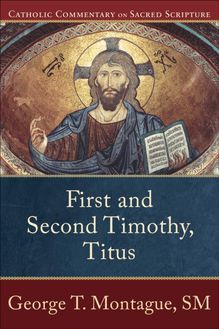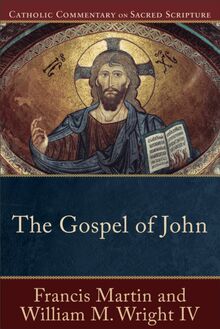Gospel of John (Catholic Commentary on Sacred Scripture) , livre ebook
210
pages
English
Ebooks
2015
Vous pourrez modifier la taille du texte de cet ouvrage
Obtenez un accès à la bibliothèque pour le consulter en ligne En savoir plus
Découvre YouScribe et accède à tout notre catalogue !
Découvre YouScribe et accède à tout notre catalogue !
210
pages
English
Ebooks
2015
Vous pourrez modifier la taille du texte de cet ouvrage
Obtenez un accès à la bibliothèque pour le consulter en ligne En savoir plus
Publié par
Date de parution
28 avril 2015
Nombre de lectures
1
EAN13
9781441222992
Langue
English
Poids de l'ouvrage
3 Mo
Publié par
Date de parution
28 avril 2015
EAN13
9781441222992
Langue
English
Poids de l'ouvrage
3 Mo
Catholic Commentary on Sacred Scripture
S ERIES E DITORS
Peter S. Williamson
Mary Healy
A SSOCIATE E DITOR
Kevin Perrotta
C ONSULTING E DITORS
Scott Hahn , Franciscan University of Steubenville
†Daniel J. Harrington, SJ , Weston Jesuit School of Theology
William S. Kurz, SJ , Marquette University
†Francis Martin , Sacred Heart Major Seminary
Frank J. Matera , Catholic University of America
George Montague, SM , St. Mary’s University
Terrence Prendergast, SJ , Archbishop of Ottawa
© 2015 by Francis Martin and William M. Wright IV
Published by Baker Academic
a division of Baker Publishing Group
P.O. Box 6287, Grand Rapids, MI 49516-6287
www . bakeracademic . com
Ebook edition created 2015
Ebook corrections 12.15.2017
All rights reserved. No part of this publication may be reproduced, stored in a retrieval system, or transmitted in any form or by any means—for example, electronic, photocopy, recording—without the prior written permission of the publisher. The only exception is brief quotations in printed reviews.
Library of Congress Cataloging-in-Publication Data is on file at the Library of Congress, Washington, DC.
ISBN 978-1-4412-2299-2
Imprimatur:
Most Reverend David Allen Zubik, DD
Bishop of Pittsburgh
August 25, 2014
The Nihil obstat and the imprimatur are declarations that a work is considered to be free from doctrinal or moral error. It is not implied that those who have granted the same agree with the contents, opinions, or statements expressed.
Unless otherwise indicated, Scripture texts in this work are taken from the New American Bible, revised edition © 2010, 1991, 1986, 1970 Confraternity of Christian Doctrine, Washington, DC, and are used by permission of the copyright owner. All rights reserved. No part of the New American Bible may be reproduced in any form without permission in writing from the copyright owner.
Scripture quotations labeled NJB are from THE NEW JERUSALEM BIBLE, copyright © 1985 by Darton, Longman & Todd, Ltd. and Doubleday, a division of Random House, Inc. Reprinted by permission.
Scripture quotations labeled NRSV are from the New Revised Standard Version of the Bible, copyright © 1989, by the Division of Christian Education of the National Council of the Churches of Christ in the United States of America. Used by permission. All rights reserved.
Scripture quotations labeled RSV are from the Revised Standard Version of the Bible, copyright 1952 [2nd edition, 1971] by the Division of Christian Education of the National Council of the Churches of Christ in the United States of America. Used by permission. All rights reserved.
English translation of the Catechism of the Catholic Church for the United States of America copyright © 1994, United States Catholic Conference, Inc.—Libreria Editrice Vaticana. English translation of the Catechism of the Catholic Church: Modifications from the Editio Typica copyright © 1997, United States Catholic Co nference, Inc.—Libreria Editrice Vaticana.
“The Catholic Commentary on Sacred Scripture is a landmark achievement in theological interpretation of Scripture in and for the Church. Highly recommended for all!”
— Michael J. Gorman , St. Mary’s Seminary and University, Baltimore
“I welcome with great joy the launch of this collection of commentaries on the Bible because the project corresponds perfectly to a pressing need in the Church. I am speaking about exegetical studies that are well grounded from a scholarly point of view but not overburdened with technical details, and at the same time related to the riches of ancient interpretation, nourishing for spiritual life, and useful for catechesis, preaching, evangelization, and other forms of pastoral ministry.”
— Albert Cardinal Vanhoye, SJ , Pontifical Biblical Institute, former secretary of the Pontifical Biblical Commission
“By bringing together historical background, exegetical interpretation, Church tradition, theological reflection, and pastoral application, this series promises to enkindle thoughtful discussion about the implications of the New Testament for lived Christian faith in the Church today. Its accessible format and multi-angled approach offer a model for teaching and ministry.”
— Katherine Hayes , Seminary of the Immaculate Conception
“This series promises to be spiritually and doctrinally informative, based on careful, solid biblical exegesis. The method and content of this work will be helpful to teachers of the faith at different levels and will provide a reliable guide to people seeking to deepen their knowledge and thereby nourish their faith. I strongly recommend the Catholic Commentary on Sacred Scripture.”
— Cormac Cardinal Murphy-O’Connor , Archbishop of Westminster
“The Catholic Commentary on Sacred Scripture is clearly written, sticks to the facts, treats the Bible as true history, and does not get lost in idle speculation and guesswork about the sources of the Gospels and the other books. Homilists will find here the pearl of great price and the treasure hidden in a field. Laypersons who are looking for a truly Catholic interpretation of the Bible will find it here. Those who want to know more about God’s holy word in the Bible will want to purchase the whole set.”
— Kenneth Baker, SJ , editor, Homiletics and Pastoral Review
Contents
Cover 1
Series Page 2
Title Page 3
Copyright Page 4
Endorsements 5
Illustrations 7
Editors’ Preface 9
Abbreviations 13
Introduction 15
Outline of the Gospel of John 27
The Prologue (1:1–18) 31
Successive Days of Revelation (1:19–2:12) 42
Jesus’ First Trip to Jerusalem (2:13–3:36) 62
Encounters with Jesus in Samaria and Galilee (4:1–54) 80
The Obedient Son, Lord of the Sabbath (5:1–47) 96
Jesus and Passover: Food for Eternal Life (6:1–71) 113
Jesus at the Festival of Tabernacles I (7:1–52) 135
Jesus at the Festival of Tabernacles II (7:53–8:59) 150
The Light of the World: Illumination and Judgment (9:1–41) 171
The Good Shepherd and the Festival of Dedication (10:1–42) 186
The Resurrection and the Life (11:1–54) 200
Jesus Goes to Jerusalem for His Passover (11:55–12:50) 215
On the Night before He Died (13:1–30) 232
Farewell Discourse I (13:31–14:31) 240
Farewell Discourse II (15:1–16:4a) 254
Farewell Discourse III (16:4b–33) 265
Jesus’ Prayer of Communion (17:1–26) 276
The Hour Begins (18:1–27) 289
The Trial before Pilate (18:28–19:16a) 298
No Greater Love (19:16b–42) 315
Encountering the Risen Lord (20:1–31) 331
The Church’s Witness to the Risen Lord (21:1–25) 347
Suggested Resources 357
Glossary 359
Index of Pastoral Topics 363
Index of Sidebars 365
Map 367
Back Cover 368
Illustrations
Figure 1. Jordan River 44
Figure 2. Map of Galilee 56
Figure 3. Mount Gerizim 87
Figure 4. Model of the pools of Bethesda 97
Figure 5. Sea of Galilee at sunset 116
Figure 6. Model of the temple sanctuary 157
Figure 7. Pool of Siloam 174
Figure 8. Sheepfold 188
Figure 9. Mikveh 216
Figure 10. The Church of the Upper Room 234
Figure 11. The Kidron Valley and the Mount of Olives 291
Figure 12. Cast of the remains of a crucified man’s foot 317
Figure 13. Hyssop 323
Figure 14. Rock tomb with a rolling stone 333
Editors’ Preface
The Church has always venerated the divine Scriptures just as she venerates the body of the Lord. . . . All the preaching of the Church should be nourished and governed by Sacred Scripture. For in the sacred books, the Father who is in heaven meets His children with great love and speaks with them; and the power and goodness in the word of God is so great that it stands as the support and energy of the Church, the strength of faith for her sons and daughters, the food of the soul, a pure and perennial fountain of spiritual life.
Second Vatican Council, Dei Verbum 21
Were not our hearts burning [within us] while he spoke to us on the way and opened the scriptures to us?
Luke 24:32
The Catholic Commentary on Sacred Scripture aims to serve the ministry of the Word of God in the life and mission of the Church. Since Vatican Council II, there has been an increasing hunger among Catholics to study Scripture in depth and in a way that reveals its relationship to liturgy, evangelization, catechesis, theology, and personal and communal life. This series responds to that desire by providing accessible yet substantive commentary on each book of the New Testament, drawn from the best of contemporary biblical scholarship as well as the rich treasury of the Church’s tradition. These volumes seek to offer scholarship illumined by faith, in the conviction that the ultimate aim of biblical interpretation is to discover what God has revealed and is still speaking through the sacred text. Central to our approach are the principles taught by Vatican II: first, the use of historical and literary methods to discern what the biblical authors intended to express; second, prayerful theological reflection to understand the sacred text “in accord with the same Spirit by whom it was written”—that is, in light of the content and unity of the whole Scripture, the living tradition of the Church, and the analogy of faith ( Dei Verbum 12).
The Catholic Commentary on Sacred Scripture is written for those engaged in or training for pastoral ministry and others interested in studying Scripture to understand their faith more deeply, to nourish their spiritual life, or to share the good news with others. With this in mind, the authors focus on the meaning of the text for faith and life rather than on the technical questions that occupy scholars, and they explain the Bible in ordinary language that does not require translation for preaching and catechesis. Although this series is written from the perspective of Catholic faith, its authors draw on the interpretation of Protestant and Orthodox scholars and hope these volumes will serve Christians of other traditions as well.
A variety of features are designed to make the commentary as useful as possible. Each volume











